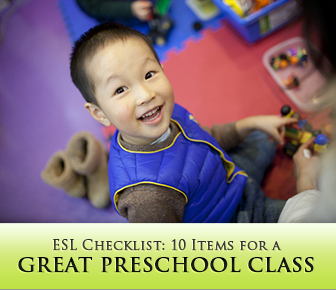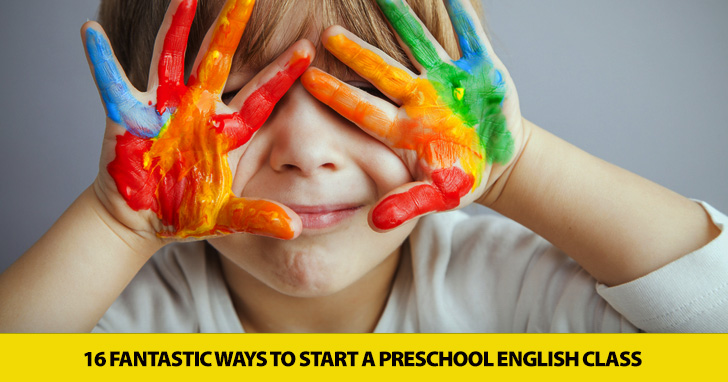ESL Checklist: 10 Items for a Great Preschool Class


Not only do preschool ESL teachers have to teach language, they also have to teach general knowledge and appropriate social behavior to their students. The good news is that almost any activity a preschool teacher would do in an English only classroom will also teach language concepts, and that includes different strategies for starting class. When the bell has rung, try circling up your kids for one of these great ways to start the day.

Depending on what the drop off policy is in your preschool, you can use this activity to greet each student at the start of the day. Have your class line up outside the classroom and enter one at a time. As children enter, ask each a question or have a short casual conversation with each child. This will give each of your students individualized attention which is so necessary at that age and, if done consistently, will give you a good read on how comfortable your students are with some of the basics of English conversation.
Who doesn’t love puppets? They are especially appealing to young students, and your class will love if you start the day with a puppet on your hand. If you choose to start the day with a regular classroom friend or mascot, let the puppet greet your students at your first circle time. You can also add to the personality appeal of your puppet by having it make frequent mistakes in its language use. Have the puppet say simple mistakes like, “Hello. How are me?” and let the kids relish in correcting their silly puppet friend.
Though English speakers say hello just about every day, that doesn’t mean saying a daily hello in your preschool class has to be boring. Give your hello of the day a theme, and have your students say hello in that same theme. The theme could tie in to whatever lesson you are teaching right now. For example, if you are having a cowboy theme, have students say howdy instead of hello. If you are doing a unit on body parts, have students shake hands to greet you and each other. There are endless ways you can stylize your hellos to match your current language unit.
Your stylized hellos don’t have to tie into a current theme that you are teaching. You can do a simple stylized hello by just having your students say hello in a particular manner – fast, slow, high-pitched, etc. It’s a great way to review specific adjectives and adverbs with your students in a fun and low pressure way.
Just like a favorite children’s television show, you can start your class by introducing your kids to the word of the day. It doesn’t have to be a complicated word, but it can be. (Never underestimate young learners.) The key is explaining the word to your students in a way that they can understand. For example, if you wanted to teach them the word soft, you could pass around several soft items (a stuffed animal, a blanket, a cotton ball, etc.). The more your students can get their hands on something, the more easily they will remember the word you are trying to teach. Then give prizes to any students who notice when you use the word throughout the day.
Songs are a great way to start the day in preschool. Choose your favorite hello song (you can find plenty on YouTube or write your own) and sing that song every day. If you like, vary some small part of the song after your students know it well. If you like, include actions with your song like shaking hands and waving to each other, tipping an imaginary cap, or bowing to each other.
If your students come to class full of energy and struggling to sit still while you teach, an action song might be right for your class. Play a song they already know tied into the season or theme you are teaching that will get them moving and/or require them to interact with you and each other. Again, you can find lots of these songs online. Try songs for specific holidays, seasons, or themes you are teaching on.
Total Physical Response is one of the most useful teaching methods for young children (as well as students of all ages, but that’s another article). You can start your days with a TPR lesson that gets students moving and introduces or reviews English vocabulary with them. Try having your students stand up, sit down, pick up pencils, go to certain areas of the room, or other actions that use words you want them to learn.
Circle time is a good way to start the day for classes that are more subdued when they come into class. Have students sit in a circle and introduce the main lesson for the day, teach them about someone or something important, or show them an experiment that they can do on their own later in the day.
Preschoolers are innately curious beings, and just giving them an open session for questions might be the best way for you to start your class. Give students a chance to talk or ask questions and then give them your answers. This can make other lesson times during the day more controlled since students will have already had a chance to get out words that are just burning to get out.
Calendar time is often how preschool teachers start their days, and your ESL class doesn’t have to be an exception. Calendar time is great for reviewing the days of the week and the months of the year. You can also use the time to review and practice English numbers if you count the total number of days school has been in session. Count by ones, tens, and hundreds once the total number of days gets that high.
Talking about the weather is another good way to start preschool ESL classes. You can post a sign for today’s weather, talk about yesterday’s weather, and make predictions about tomorrow’s weather. Make sure you have an area on your wall where you can post the different weather words and where you can display the one that best describes the world on the other side of the windows.
Who says you can’t start the day with review? In fact, it’s great for activating schemata and getting your students to a place where they are ready to learn. For your review time, you can go over previous English lessons, talk about a picture, look at flash cards, etc. Tailor your review time to the personality and needs of your class to make it most effective.
For a simple and engaging way to introduce new vocabulary, start your day by taking a vote. Give your students two items to choose from and ask each person to raise their hand for the one they like best. You can ask if students like dogs or cats better or if they would rather run or read a book. When students raise their hands, count them and then write the results of your vote on the board. You can tie your morning vote into any lesson theme you are doing or plan to do.
Books are prevalent in the preschool classroom, and if your kids are able to sit and focus first thing in the day, try reading a book. Choose a book that ties into what you will teach that day or a theme you are doing in class, and then leave it out for the rest of the day so students can go back and look at the pictures during free learning periods.
A question is a simple but effective way to start the day in a preschool classroom. Try asking one student a question and then passing them a stuffed animal or other object. They hold that object as they answer and then ask the same question to another person in class before passing on the stuffed animal to them. That person then answers the question, asks someone else, and passes the toy along. Continue until everyone has had a chance to answer and ask the question finishing up by answering the question yourself and taking back the stuffed animal.
There are so many ways to start a preschool ESL class, we can’t begin to discuss all of them in one article. One thing you do want to aim for is consistency. Young children thrive on it, so find a method of starting class that works for you and stick with it.
We want to hear them!